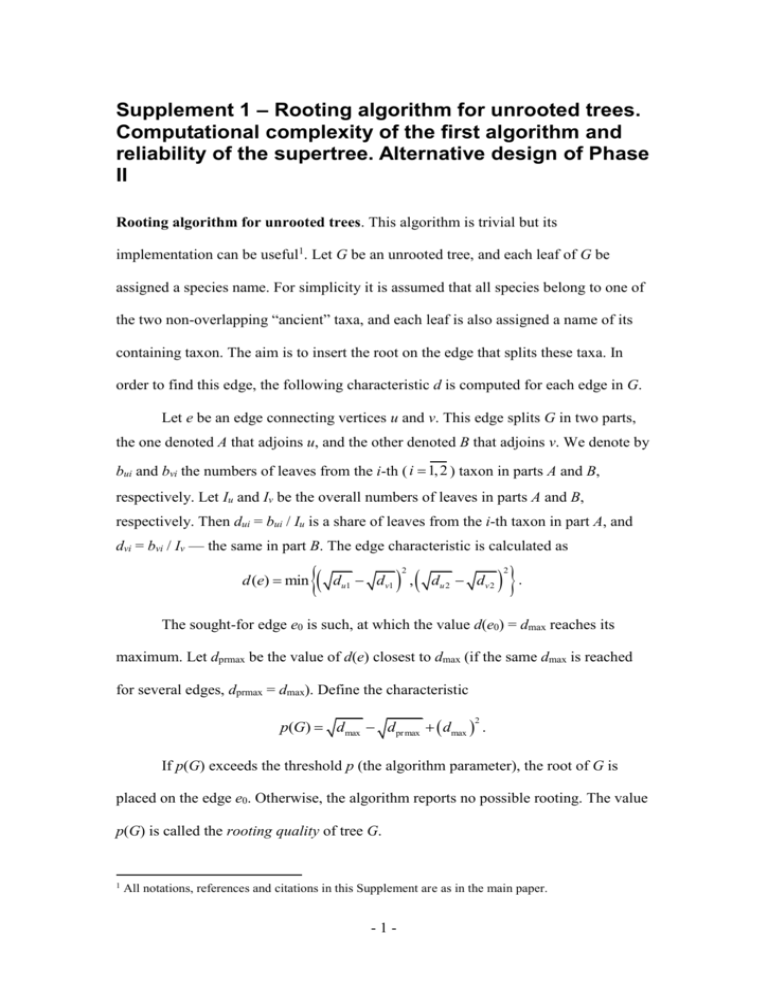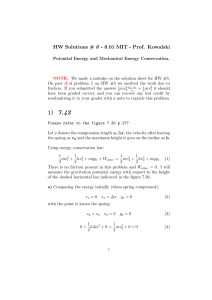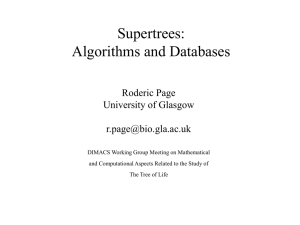Supplement 1 - BioMed Central
advertisement

Supplement 1 – Rooting algorithm for unrooted trees.
Computational complexity of the first algorithm and
reliability of the supertree. Alternative design of Phase
II
Rooting algorithm for unrooted trees. This algorithm is trivial but its
implementation can be useful1. Let G be an unrooted tree, and each leaf of G be
assigned a species name. For simplicity it is assumed that all species belong to one of
the two non-overlapping “ancient” taxa, and each leaf is also assigned a name of its
containing taxon. The aim is to insert the root on the edge that splits these taxa. In
order to find this edge, the following characteristic d is computed for each edge in G.
Let e be an edge connecting vertices u and v. This edge splits G in two parts,
the one denoted A that adjoins u, and the other denoted B that adjoins v. We denote by
bui and bvi the numbers of leaves from the i-th ( i 1, 2 ) taxon in parts A and B,
respectively. Let Iu and Iv be the overall numbers of leaves in parts A and B,
respectively. Then dui = bui / Iu is a share of leaves from the i-th taxon in part A, and
dvi = bvi / Iv — the same in part B. The edge characteristic is calculated as
d (e) min
du1 dv1
,
2
du 2 d v 2
.
2
The sought-for edge e0 is such, at which the value d(e0) = dmax reaches its
maximum. Let dprmax be the value of d(e) closest to dmax (if the same dmax is reached
for several edges, dprmax = dmax). Define the characteristic
p(G) dmax dpr max dmax .
2
If p(G) exceeds the threshold p (the algorithm parameter), the root of G is
placed on the edge e0. Otherwise, the algorithm reports no possible rooting. The value
p(G) is called the rooting quality of tree G.
1
All notations, references and citations in this Supplement are as in the main paper.
-1-
In some cases, leaves of the tree become assigned to more than two “ancient”
taxa. If so, these taxa are sorted such that distant taxa appear in different groups, and
the above described procedure is re-applied.
It often makes sense to prune low-supported edges off tree G before rooting. If
pruning is requested, one unrooted tree can result in several rooted trees.
This algorithm was implemented as a collection of php scripts freely available
at the Web page [19].
Complexity. The runtime of Phase II of the algorithm under the standard P has the
order of O(n·m4) (if is calculated as in [2], henceforth referred to as “case A”) or
the order of O(n·m6) (if is calculated as in [3], henceforth referred to as “case B”),
and under an arbitrary P it has the order of O(|P|·m3) (case A) or the order of
O(|P|·m5) (case B). In case of the standard P the corresponding runtime n·m6 of Phase
II does not exceed the runtime m3n3 of Phase I if the number of trees n is not less than
m3/2, [8]. The latter can be true for example, for 100 species and 1000 gene trees.
The total runtime of both phases under the standard P has the order of
O(n·m3(n2+m)) (case A) or O(n·m3(n2+m3)) (case B), and under any P it has the order
of O(|P|3+|P|2nm+|P|·m3) (case A) or O(|P|3+|P|2nm+|P|·m5) (case B).
In case of large input data Phase II can be realized with a simpler algorithm.
The idea behind it is to compute the quality score of tree S not based on mapping but
on its underlying topologies.
A topology {a, b, c} is equivalent to a tree with three leaves, a, b, and c.
Define the quality Q(t) of topology t = t(a,b,c) for a triplet of leaves (i.e., species) a,
b, c with the formula
w
(
V
)
Q
(
t)
,
w
(
V
)
w
(
V
)
1
kK
m
M
m
k
n
N
n
where K is a set of basic trees that contain the triplet and induce the topology t in it;
M, N are sets of basic trees that also contain the triplet but induce two alternative
topologies in it. Given a species tree S, the total quality of topologies t = t(a,b,c)
-2-
induced by S for all triplets {a, b, c} of leaves-species, a, b, c in S is called the quality
Q(S) of the tree S, i.e.,
Q( S )
{a ,b ,c}S
Q t (a, b, c) .
Reliability. The vertex reliability in the final supertree S and the overall reliability of
S are estimated as follows. Let R be a clade corresponding to a given inner vertex s.
Denote R(V0) a set of all triplets {a,b,c} of species from V0 that have only two
member species belonging to R. For a triplet {a,b,c} from R(V0) denote R{a,b,c} a
unique topology on {a,b,c} such that the two elements of {a,b,c} belonging to R are
siblings in R{a,b,c}. The ratio
{
a
,b
,c
}
R
Q
{,
ab
,c
}
R
(
V
)
0
v
()
s
Q
()
t
,
{,
ab
,c
}
R
(
V
) t
0
where t runs over all topologies on {a, b, c} is called the reliability of vertex s. If the
denominator of this ratio equals zero for vertex s (in which case the numerator is zero
too), it is assumed that v(s) = –1. The minimum reliability over all vertices in S gives
the reliability of S.
Alternative design of Phase II. Assume that all trees are orientated downwards from
the root, and let V0 be a set of all species from all Gi as above. A three-leaved seed
tree induces a topology t(a,b,c) of maximum quality over all topologies of all triplets
of species from V0. Each edge in the current partial supertree S is attempted for
insertion of a new vertex a connected to each of the remaining species s from V0, and
also for placing of a new root a above the current root, Fig. 4. Among such possible
extensions T of S, we choose the tree T of the maximum quality Q(T ) ; it supersedes
the current partial supertree S. Extensions are attempted until all species from V0 are
added in the current tree, and the algorithm halts. The end of alternative Phase II.
Further research is needed to identify cases when the two alternative designs
of Phase II produce different results.
-3-











